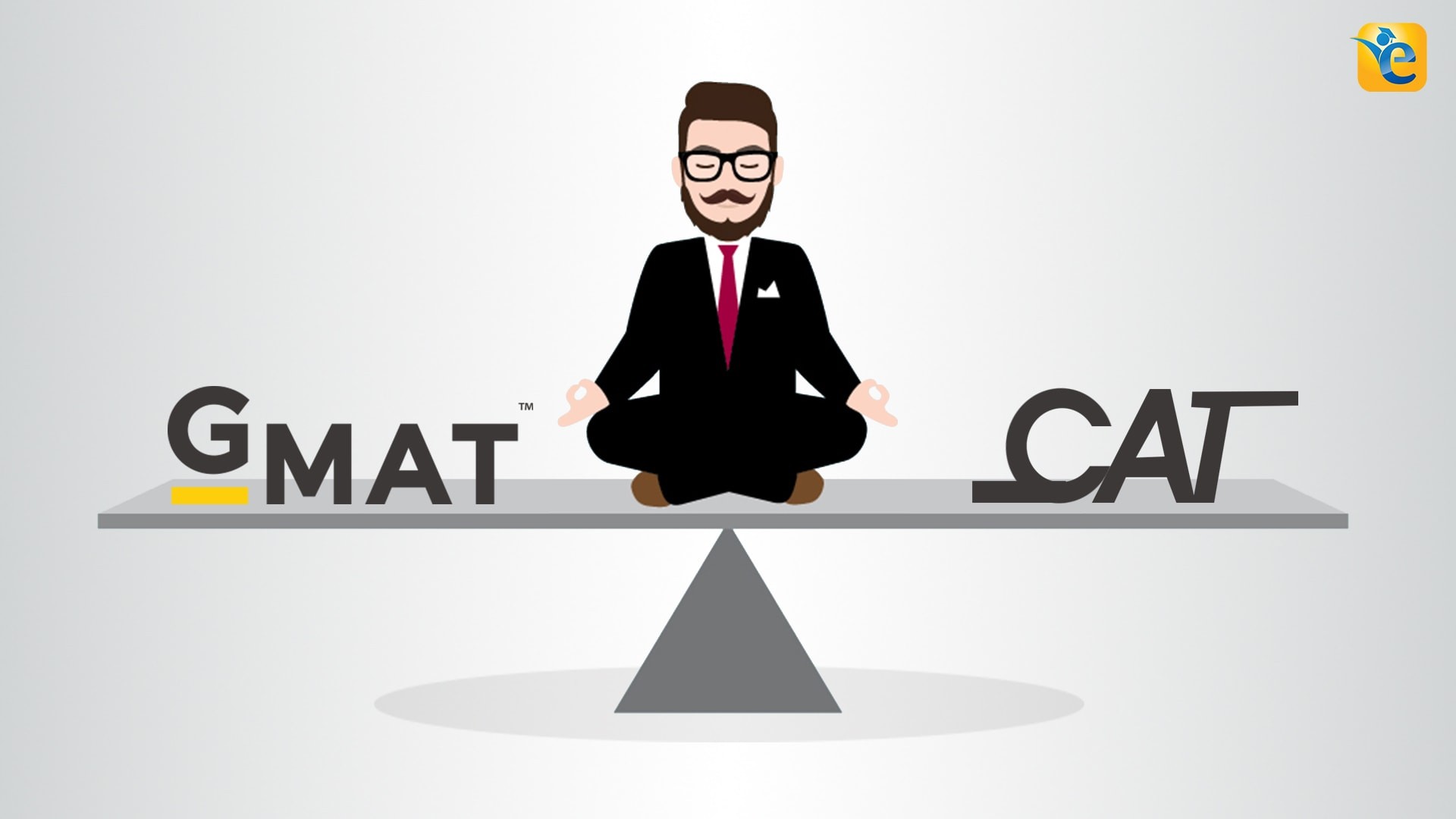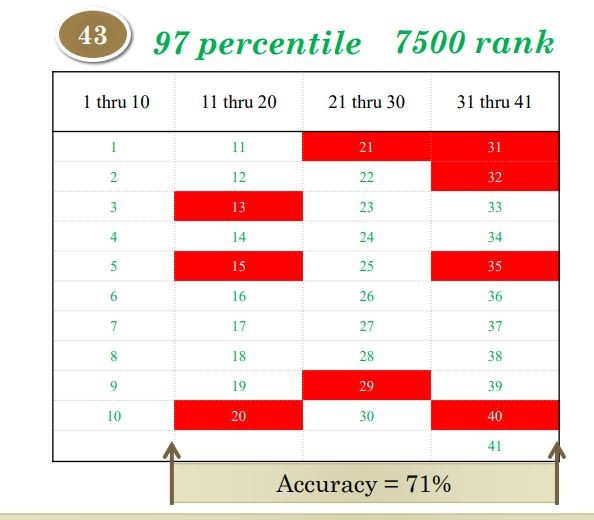Are you wondering how tough the GMAT is compared to the CAT? This comprehensive guide on COMPARE.EDU.VN provides a detailed comparison of the GMAT and CAT exams, analyzing their difficulty, syllabus, format, and other crucial factors. By understanding the nuances of each exam, you can make an informed decision about which test best aligns with your strengths and aspirations, leading you toward your MBA goals. Explore differences in quantitative aptitude and verbal reasoning.
1. Understanding the GMAT and CAT Exams
Both the GMAT (Graduate Management Admission Test) and the CAT (Common Admission Test) are standardized tests used for admission to MBA programs. However, they differ significantly in their scope, acceptance, format, and difficulty. Let’s delve into the specifics.
The GMAT is a globally recognized exam, accepted by over 7,000 MBA programs in 110 countries. It’s administered by the Graduate Management Admission Council (GMAC). A GMAT score opens doors to top business schools in the U.S., the UK, Europe, Singapore, and Canada. Even in India, many top B-schools accept GMAT scores, especially for their executive programs.
The CAT, on the other hand, is a national-level exam primarily for admission to Indian business schools, including the prestigious Indian Institutes of Management (IIMs).
1.1. GMAT vs CAT: Key Differences at a Glance
| Feature | CAT | GMAT |
|---|---|---|
| Full Form | Common Admission Test | Graduate Management Admission Test |
| Conducting Body | Indian Institute of Management (IIM) | Graduate Management Admission Council (GMAC) |
| Validity | 1 Year | 5 Years |
| Eligibility | Bachelor’s Degree with 50% Marks | At Least 13 Years of Age (Parental Consent Required if Under 18) |
| Attempts per Year | 1 | 5 |
| Acceptance | Indian Business Schools | Global Business Schools |
| Exam Mode | Online (at Test Centers) | Online (at Test Centers or at Home) |
| Sections | 3 | 3 |
| Questions | 66 (VARC: 24, QA: 22, DILR: 20) | 64 (QR: 21, VR: 23, DI: 20) |
| Duration | 120 Minutes | 135 Minutes |
| Exam Fee (Approx.) | ₹2,400 (Approximately $29 USD) | $275 (Test Center) / $300 (Online) |
| Negative Marking | Yes | No |
| Adaptive Testing | No | Yes |



1.2. Format and Structure: How Do They Differ?
Both exams have three sections. However, the GMAT uses adaptive testing, meaning the difficulty of questions adjusts based on your performance. The CAT does not have this feature; all questions are pre-determined.
- GMAT: Quantitative Reasoning, Verbal Reasoning, and Data Insights.
- CAT: Verbal Ability and Reading Comprehension (VARC), Data Interpretation and Logical Reasoning (DILR), and Quantitative Ability (QA).
2. Diving Deeper: Exam Difficulty
The perception of difficulty is subjective and depends on individual strengths and weaknesses. However, we can analyze the exams based on various parameters to understand their relative difficulty.
2.1. Quantitative Ability
- CAT: The CAT’s quantitative section is generally considered more challenging than the GMAT’s. It often includes more complex and calculation-intensive problems.
- GMAT: While still demanding, the GMAT’s quantitative section focuses on fundamental concepts and problem-solving skills. The emphasis is on logical reasoning rather than intricate calculations.
2.2. Verbal Ability
- GMAT: For non-native English speakers, the GMAT verbal section can be more challenging due to its emphasis on grammar, critical reasoning, and reading comprehension of complex passages.
- CAT: The CAT’s verbal section focuses more on reading comprehension and vocabulary, which might be comparatively easier for some test-takers.
2.3. Data Interpretation and Logical Reasoning
- CAT: This section tests your ability to analyze data presented in various formats (tables, graphs, charts) and solve logical reasoning puzzles. It requires strong analytical skills and the ability to identify patterns and draw inferences.
- GMAT: The GMAT’s Data Insights section includes similar skills but also integrates data sufficiency questions, which require you to determine whether the provided information is sufficient to answer a given question.
2.4 Adaptive Testing
The GMAT’s adaptive nature adds another layer of complexity. The test adjusts to your skill level, making it crucial to perform well on the initial questions. This can be intimidating, but it also allows the test to accurately gauge your abilities.
2.5. Syllabus Comparison
The GMAT has a more defined syllabus, making it easier to prepare for. Experts suggest that 90-120 hours of focused preparation can lead to a high percentile on the GMAT. The CAT syllabus, on the other hand, is broader and less defined, requiring more extensive preparation.
3. Detailed Syllabus Breakdown
Understanding the syllabus is crucial for effective preparation. Here’s a detailed comparison of the topics covered in each exam:
3.1. Verbal Syllabus: GMAT vs CAT
| CAT | GMAT |
|---|---|
| Fill in the Blanks | Verb Tense |
| Grammar | Pronoun |
| Para Completion and Inference | Subject-Verb Agreement |
| Reading Comprehension | Modifiers |
| Verbal Logic | Idioms |
| Para Jumbles | Parallelism |
| Verbal Reasoning | Comparison |
| Syllogisms | Inference |
| Contextual Usage | Assumption |
| Analogies | Evaluate |
| Different Usage of the Same Word | Strengthen and Weaken |
| Antonyms | Boldface |
| Sentence Completion | Paradox |
| Jumbled Paragraphs | |
| Foreign Language Words Used in English | |
| Sentence Correction | |
| Idioms | |
| One Word Substitution |
Note: The GMAT Focus Edition has removed sentence correction, which used to be a significant part of the verbal section.
3.2. Quantitative Syllabus: GMAT vs CAT
| CAT | GMAT Focus Edition (GFE) |
|---|---|
| Geometry | Number Properties |
| Trigonometry | Multiples and Factors |
| Mensuration | Fractions |
| Ratios and Proportion | Decimals |
| Number System | Percentages |
| Work and Time | Averages |
| HCF & LCM | Exponents |
| Algebra | Profit and Loss |
| Profit & Loss | Simple and Compound Interest |
| In-equations Quadratic and Linear Equations | Speed, Time, and Distance |
| Geometric Progression | Pipes, Cisterns, and Time Work |
| Arithmetic Progression | Ratio and Proportion |
| Averages | Mixtures and Allegations |
| Partnership (Accounts) | Descriptive Statistics |
| Time-Speed-Distance | Set Theory |
| Surds and Indices | Probability |
| Inequalities | Permutation and Combination |
| Logarithms | Monomials, Polynomials |
| Percentages | Algebraic Expressions and Equations |
| Functions | |
| Arithmetic and Geometric Progression | |
| Quadratic Equations | |
| Inequalities and Basic Statistics |
Note: Geometry has been removed from the GMAT Focus Edition.
4. GMAT Focus Edition vs CAT: A Modern Comparison
The GMAT Focus Edition (GFE) has narrowed the gap between the two exams. The new Data Insights section and the removal of the Analytical Writing Assessment (AWA) make the GMAT more similar to the CAT in structure.
4.1. CAT vs GMAT Focus Edition: Key Differences
| Parameter | CAT | GMAT Focus Edition |
|---|---|---|
| Test Duration | 2 Hours | 2 Hours 15 Minutes |
| Number of Sections | 3 | 3 |
| Section Names | Quantitative Ability (QA), Verbal Ability and Reading Comprehension (VARC), Data Interpretation and Logical Reasoning (DILR) | Quantitative Reasoning (QR), Verbal Reasoning (VR), Data Insights (DI) |
| Section Duration | 40 Minutes Each | 45 Minutes Each |
| Number of Questions | 66 (QA: 22, VARC: 24, DILR: 20) | 64 (QR: 21, VR: 23, DI: 20) |
The overlap in syllabus and format means that preparing for both exams simultaneously is now more feasible. Focusing on strengthening your Data Insights, quantitative, and verbal reasoning skills will benefit you on both tests.
5. Making the Right Choice: Factors to Consider
Choosing between the GMAT and CAT depends on your individual circumstances and career goals. Consider the following factors:
5.1. Career Aspirations
- Global Ambitions: If you aspire to study and work abroad, the GMAT is the clear choice due to its worldwide recognition.
- Domestic Focus: If you prefer to remain in India, the CAT is the preferred option, as it’s accepted by all IIMs and other top Indian B-schools.
5.2. Program Selection
- Specific Programs: Some programs may require one exam over the other. For instance, the regular 2-year MBA program at an IIM requires a CAT score, while the 1-year executive programs often accept GMAT scores.
- International Students: If you’re an international student applying to Indian B-schools, a GMAT score might be necessary.
5.3. Location Preference
If you have a strong preference for studying in a specific region, research which exams are favored by the B-schools in that area.
5.4. Investment vs Return
The GMAT has a higher upfront cost but offers greater long-term value due to its five-year validity and wider acceptance.
5.5 Cost Comparison: GMAT vs CAT (Approximate)
| Expense | GMAT | CAT |
|---|---|---|
| Test Fee | $275 | $29 |
| Preparation Cost | $349 (e-GMAT Course) | $450 (Average Classroom Coaching) |
| Rescheduling Cost | $50 – $150 (Depending on Timing) | Not Possible (Exam Once a Year) |
| Score Reporting | $35 Each (First 5 Free) | Free to All IIMs |
| Enhanced Score Report | $30 | Not Available |
| Score Validity | 5 Years | 1 Year |
| Total Cost | $829 | $480 |
| Total Cost Per Year | $166 | $480 |
5.6 Scholarship Opportunities
A good GMAT score can increase your chances of securing scholarships and financial aid at top business schools. While some need-based assistance is available at IIMs, it’s often in the form of loans rather than scholarships.
6. Maximizing Your Chances of Success
Regardless of which exam you choose, thorough preparation is essential. Utilize available resources, take practice tests, and identify your strengths and weaknesses.
6.1. GMAT Preparation Resources
- e-GMAT: Known for its comprehensive online courses and personalized approach.
- Kaplan: Offers a variety of prep options, including live classes and self-paced courses.
- Manhattan Prep: Provides in-depth instruction and focus on specific skill areas.
- Official GMAT Materials: Include practice tests and questions from past exams.
6.2. CAT Preparation Resources
- Coaching Institutes: TIME, Career Launcher, and IMS are popular coaching centers in India.
- Online Platforms: Websites and apps offer practice tests, study materials, and mock exams.
- Previous Years’ Papers: Solving past CAT papers is crucial for understanding the exam pattern and difficulty level.
7. Test-Taking Strategies
- Time Management: Practice time management techniques to ensure you can complete all sections within the allotted time.
- Accuracy: Aim for accuracy over speed. It’s better to answer fewer questions correctly than to rush through and make mistakes.
- Adaptive Testing (GMAT): Focus on answering the initial questions correctly, as they have a significant impact on your score.
- Negative Marking (CAT): Be cautious when answering questions you’re unsure of, as there’s a penalty for incorrect answers.
8. Additional Tips and Considerations
- Start Early: Begin your preparation well in advance to allow ample time to cover the syllabus and practice effectively.
- Set Realistic Goals: Set achievable targets and track your progress to stay motivated.
- Stay Updated: Keep abreast of any changes in the exam format or syllabus.
- Seek Guidance: Consult with mentors, counselors, or experienced test-takers for advice and support.
- Manage Stress: Maintain a healthy lifestyle and manage stress to perform at your best on test day.
9. Conclusion: Making an Informed Decision
Ultimately, the “toughness” of the GMAT compared to the CAT depends on your individual profile, strengths, and aspirations. By carefully evaluating the factors discussed in this guide, you can make an informed decision and choose the exam that best aligns with your MBA goals. Both the GMAT and CAT are challenging exams that require dedicated preparation and strategic thinking.
Remember, a good GMAT score offers broader global opportunities and better ROI in the long run. However, if you are targeting the traditional 2-year MBA program at IIMs or other top Indian B-schools, the CAT might be your only option. At COMPARE.EDU.VN, we aim to provide you with the most comprehensive and objective comparisons to help you make the best decisions for your future.
10. Frequently Asked Questions (FAQs)
10.1. Has the CAT format changed recently?
Yes, the timing of each section changed in CAT 2021, with 40 minutes per section. The number of questions remained the same.
10.2. How many business schools accept GMAT scores?
More than 7000 MBA programs at over 2500 business schools worldwide accept GMAT scores.
10.3. How many business schools accept CAT for MBA admissions?
Over 1200 MBA colleges in India, including the 20 IIMs, accept CAT scores.
10.4. How many times can I take the CAT and GMAT in a year?
You can take the GMAT 5 times in a year, while you can take the CAT only once a year.
10.5. What is the validity of GMAT and CAT scores?
GMAT scores are valid for 5 years, and CAT scores are valid for only 1 year.
10.6. Do IIMs accept GMAT scores?
Yes, many IIMs and other Indian business schools accept GMAT scores for their 1-year Executive MBA programs.
10.7. What is a good GMAT score for IIMs?
A 645+ is considered a good GMAT score for the executive MBA programs at top IIMs.
10.8. Is there negative marking in the GMAT and CAT exams?
There is no negative marking in the GMAT, but marks are deducted for wrong answers in the CAT exam.
10.9. Are the GMAT and CAT exams accepted globally?
The GMAT is recognized worldwide, while CAT scores are accepted only by business schools in India.
Are you ready to conquer your MBA dreams? Let COMPARE.EDU.VN be your guide! We provide comprehensive comparisons and insights to help you make informed decisions.
Ready to make a choice? Visit COMPARE.EDU.VN today and explore our detailed comparisons to find the best option for your academic and career aspirations. Don’t just compare – decide!
For further assistance, contact us at:
Address: 333 Comparison Plaza, Choice City, CA 90210, United States
WhatsApp: +1 (626) 555-9090
Website: compare.edu.vn
